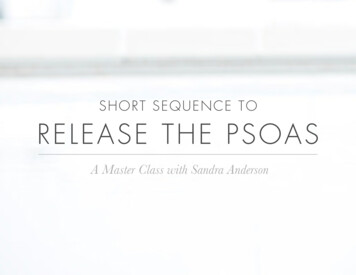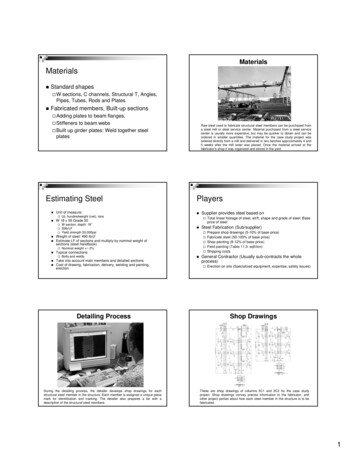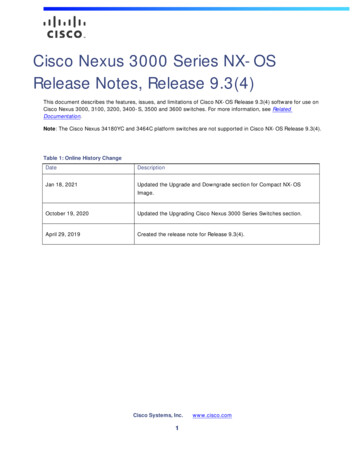
Transcription
SHO RT SEQUENCE TORELEAS E THE PSOASA Master Class with Sandra Anderson
THE PRACTICETightness or discomfort inthe psoas can often be anindicator of tensionelsewhere in the body,anxiety, or pent-upinternal stimulation.Cultivating deep presenceis the first step towardreleasing the psoas andrelieving pain. Use yourbreath awareness andyour conscious intentionto relax the mind andbody, and to allow thisdeep presence to arise.This will pacify the psoas,so that it relaxes andreleases.
Begin in a savasana(corpse pose)modification, with abolster under your kneesto allow the psoas torelax.Soften the back side ofyour body. Let the ribcage drop into the matand the back to rest onthe floor.Let go of any effort inyour body, breathing,and mind. Release anyjudgment about whetheryou’re doing the practicecorrectly.Allow your awarenessand breath to dropdeeper into the body.
AP ANASANA( DR AW O NE KNEE TO T HE C HES T)Hands wrapped behind the knee and around the back of the thigh.Soften your back ribs toward the floor.Notice your breath. Does it indicate any deeper tension that may be stuck in this area?If you'd like to increase the depth of the stretch, lift your hips and pull the bolster underneathyour pelvis and sacrum (but not your lower back).You may be able to extend the opposite leg. If so, keep your extended leg active by pushingthrough the heel.For an even more energetic option, do this against a wall, so that the heel of your extendedleg is pushing against it.Gently, smoothly release and draw the other knee up and repeat on the other side.Finally, lift the hips and draw the bolster out from underneath you. Then lower your hips tothe mat.
WINDS HIEL D WI P ER POSE( DR O P PI NG THE KNEES F ROM SIDE T O SIDE)Separate the feet about mat-width (or perhaps not quite that wide, if your legs tend to beshorter).Gently lower the knees to one side.Bring your knees back to center and take them to the other side.Windshield-wiper your knees back and forth as many times as feels right to you.
ABD OMINALWORKExtend the left leg on the floor. Reach outthrough the heel, which creates a nice, longopening across the psoas and groin area, aswell as engagement in the deeperabdominal muscles.The next exercise activates the deepabdominal muscles, so that the musculatureresponsible for stabilizing the pelvis and thelumbar spine is engaged. This frees thepsoas so that it can properly flex the hipjoint.You might also lift the extended leg an inchor two.Bring the right knee to the chest, holding itbehind the knee with the right hand.Bring the left hand behind the head tosupport the head and neck.Create resistance by pushing the leg awayfrom you while pulling the hand toward you,actively pushing the thigh into the hand.Roll up, lifting your shoulder blades andupper body.Relax and breathe, even as your muscles areactive.Come out by bringing both feet to the floorand repeat on the other side.Afterward, draw your knees to your chestand rock side to side slightly, to relieve anyresidual strain in the lower back.
EK A PA DA RAJA K A P OTASANA( HAL F PI G EON P OS E)Roll onto your right side and come onto your hands and knees for a variation of eka padarajakapotasana (half pigeon pose) that lengthens the psoas. This version also neutralizes theexternal hip rotators, so that the tightness you often feel in your outer hip, which preventsyou from getting a stretch in your psoas, is removed.Draw your left knee forward, so that you are on your shin, and place it to the inside of the lefthand.Slide the right foot down the mat, so that the heel of the left foot is underneath the left hip.Align the left shin and foot so that they are parallel with the long edge of the mat.If you feel any strain in the knee, come out of this variation and turn the lower leg tocome into a standard half pigeon pose, with the shin parallel to the short edge of the mat.You can also come into a low or high lunge, or skip the pose entirely, if needed.
Walk your fingertips back toward your hips, so that there’s a strong lift up through the frontof the body. Rather than curling into a tight “ball,” the psoas is now opening from both thetop and bottom ends. This allows the pelvis to move down. The position of the legs alsostabilizes the pelvis and allows you to lift straight up out of it.Wherever you need to, stop walking your fingers back. You may not be able to come uprightentirely. For a modification, you can also put blocks under your hands to aid you.Your goal is to find that edge between resistance and softening, not to master a particularposition. Coax the releasing of this deep muscle, rather than trying to bully it into position.Aim for just enough engagement so that you can soften while the muscle is active. Whenyou reach that point, you may be able to move in a little deeper and engage a little bit more.To come out, fold forward and return to your hands and knees, or into adho mukhasvanasana (downward facing dog), if you prefer. Then step into the pose again, this timedrawing the right knee forward.Remember that it’s natural to experience a difference from side to side.When you’re ready to come out, come into child’s pose or downward facing dog.
ANJANEYASANA( LO W L U NGE)Come back to your hands and knees for anjaneyasana, which will help open the groin.Step the right foot forward, with the ankle under the knee for stability.Fold your hands over your thigh and press into the thigh (alternately, you can press yourhands into blocks, one on either side), which will help you lift up through the core of thebody.Be careful not to push out the upper chest. Instead, engage in diaphragmatic breathing andallow your breath to move deep down into the core of the body.To get more lengthening in the upper part of the psoas, you can also sweep the arms out tothe side and up alongside the head.If you’re tempted to throw your chest forward, breathe into the back ribs so the back bodystays energized. Then you can stretch up through the arms, lifting the torso off the pelvis asthe pelvis drops down.When you’re ready, exhale the arms out to the side and down.
To change sides, move into child’s pose or down dog, whichever neutralizes tension in the hip,knee, ankle, and spine.Repeat on the other side.Step back into child’s pose or downward facing dog.
S ALABHAS ANA( LO CU ST P OSE)Lie prone on the belly, hands down, forehead down or chin touching the ground.(If your neck hurts, you should have your forehead down).Bend the right knee, so your foot is in the air. Lift the thigh and press the foot to the ceiling,maintaining a right angle between the calf and the thigh.Keep the sole of the foot facing toward the ceiling.Keep the knee lifted directly up so it’s not abducting out to the side, but rather staying rightin line with the hip.It may not feel as though there’s much movement and, depending on how tight your psoas is,you may not get any movement at all; but there is still a lot going on in the pelvis. The rightside is engaged and the right side of the hip, the pelvis, and the gluteus maximus are lifting.Relax the opposite side as it engages sympathetically. This relaxation provokes a deeprealignment in the pelvis.
Lower the thigh and lift it again. Do this three to five times, keeping the pelvis on the floor.Let that leg relax and try the other side.
COUNT E R POSETo counter any pelvic tension, remain prone with the forehead down and bend both knees,feet in the air.Gently lower both feet to one side and then the other, windshield-wiping them from side toside. Do this slowly, so you notice what is happening in the pelvis.Let the pelvis move with the legs.Then, keeping knees bent, separate the shins and open the legs out to the sides. Now, drawthe legs toward one another and cross the ankles. Do that a few times, reversing which ankleis in front.Sit back in child’s pose. Breathe into your lower back and lower belly, arms resting alongsideto relieve any tension in the shoulders. If child’s pose is uncomfortable for you, roll over anddraw your knees to the chest.Roll over and lie down in savasana. Then bend your knees and drop them from side to side afew times.
SETU BAN DHA SAR VANGASANA( BR ID G E P OSE)Step your feet closer to the pelvis, about hip-width apart, and place your hands down byyour sides as you prepare for setu bandha sarvangasana.Lift the pelvis. Peeling the spine off the floor, continue to lift.Engage your inner thighs. Keep the thighs parallel and don’t let the knees splay out.Press the sacrum into the body. Lift the pelvis high.Roll down one vertebra at a time into the mat, if that’s possible. Then soften the whole spineand allow the lower back to come to its natural position.
FINALSAV AS ANA( CO RP SE P OSE)Slip the bolster under your knees again forfinal savasana. Using the bolster ensuresthat the psoas does not becomere-aggravated.Feel the lower back dropping deeper intothe floor. Allow the whole pelvis andlower back to relax.Soften the mouth, jaw, eyes, face, base ofthe skull, and front of the throat.When the body feels soft and the limbshave grown longer and heavier, think aboutthe spine growing longer as well, so theback of the spine has a more intimaterelationship with the floor.Soften the whole spine down into the floor.All of the energy of the front of the bodywill come settling down into the rest of thebody, and the breath will become moresubtle.Bring your attention to the back of thehead, the shoulder blades, the back ribs,and down into the pelvis.Do not force the breath in any way. Noticeif there is tension and holding in the breath,and allow the body to soften around that.Bring your attention to the place where thebody and breath meet. Allow the body tosoften in that interface.Feel the weight of the legs and how the legsare supported by the bolster.You can stay here for 10 to 15 minutes, if youlike, with your attention on the breath.Sense the back of your body.
Sit back in child's pose. Breathe into your lower back and lower belly, arms resting alongside to relieve any tension in the shoulders. If child's pose is uncomfortable for you, roll over and draw your knees to the chest. Roll over and lie down in savasana. Then bend your knees and drop them from side to side a few times. COUN TER POSE











